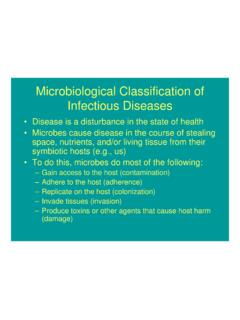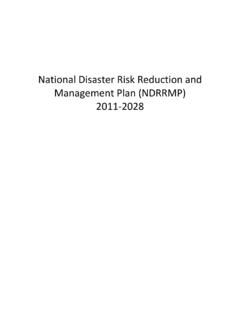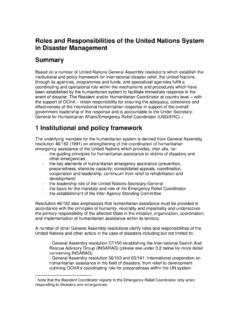Transcription of 1.1 The scope and concerns of public health
1 The scope and concerns of public health Roger Detels and Chorh Chuan Tan Abstract Introduction Functions of public health Contemporary health issues public health interventions Private support of public healthThe future of public health References Abstract public health is the art and science of preventing disease, prolonging life, and promoting health through the organized efforts of society. The goal of public health is the biologic, physical, and mental well-being of all members of society. Thus, unlike medicine, which focuses on the health of the individual patient, public health focuses on the health of the public in the aggregate.
2 To achieve this broad, challenging goal, public health professionals engage in a wide range of functions involving biological sciences, technology, social sciences, and politics. public health professionals utilize these functions to anticipate and prevent future problems, identify current problems, identify appropriate strategies to resolve these problems, implement these strategies, and finally, to evaluate their effectiveness. public health is a global issue, and will become even more so in the 21st century, as the interconnectedness of nations increases through modern communication, resulting in the need to deal with epidemics of communicable and non-communicable diseases and environmental issues that require transnational solutions.
3 Thus, public health must address the challenge of confronting health problems and political, social, and economic factors affecting health , not only at the community, state, and national levels, but at the global level as well. In this chapter, we introduce the reader to the scope and current major concerns of public health as we enter the 21st century, giving examples of each. It is the goal of this chapter to assist the readers in understanding the conceptual framework of the field, which will help them in placing the subsequent more detailed chapters into the context of the entire field of public health (1). Introduction There have been many definitions and explanations of public health .
4 The definition offered by the Acheson Report (1) has been widely accepted: public health is the science and art of preventing disease, prolonging life, and promoting health through the organized efforts of society. 2 This definition underscores the broad scope of public health and the fact that public health is the result of society s efforts as a whole, rather than that of single individuals. In 2003, Detels defined the goal of public health as: The biologic, physical, and mental well-being of all members of society regardless of gender, wealth, ethnicity, sexual orientation, country, or political views. This definition or goal emphasizes equity and the range of public health interests as encompassing not just the physical and biologic, but also the mental well-being of society.
5 Both the World health Organization (WHO) and Detels goals or definitions depict public health as being concerned with more than the mere elimination of disease. To achieve the WHO goal of health for all , it is essential to bring to bear many diverse disciplines to the attainment of optimal health , including the physical, biologic, and social sciences. The field of public health has adapted and applied these disciplines for the elimination and control of disease, and the promotion of health . Functions of public health public health is concerned with the process of mobilizing local , state/provincial, national and international resources to assure the conditions in which all people can be healthy (2).
6 To successfully implement this process and to make health for all achievable public health must perform the functions listed in Table Table Functions of public health 1. Prevent disease and its progression, and injuries. 2. Promote healthy lifestyles and good health habits. 3. Identify, measure, monitor, and anticipate community health needs. 4. Formulate, promote, and enforce essential health policies. 5. Organize and ensure high-quality, cost-effective public health and health -care services. 6. Reduce health disparities and ensure access to health care for all. 7. Promote and protect a healthy environment.
7 8. Disseminate health information and mobilize communities to take appropriate action. 9. Plan and prepare for natural and man-made disasters. 10. Reduce interpersonal violence and aggressive war. 11. Conduct research and evaluate health -promoting/disease-preventing strategies. 12. Develop new methodologies for research and evaluation. 13. Train and ensure a competent public health workforce. Source: Adapted from Office of the Director, National public health Performance Standards Program. 10 essential public health services. [Online]. Centers for Disease Control; 1994. (Available from: ) and Pan American health Organization.
8 Essential public health services. [Online]. 2002. (Available from: ) 3 public health identifies, measures, and monitors community and global health needs through surveillance of disease and risk factor ( smoking) trends. Analysis of these trends and the existence of a functioning health information system provides the essential information for predicting or anticipating future community health needs. In order to ensure the health of the population, it is necessary to formulate, promote, and enforce sound health policies to prevent and control disease, and to reduce the prevalence of factors impairing the health of the community.
9 These include policies requiring reporting of highly transmissible diseases and health threats to the community and control of environmental threats through the regulation of environmental hazards ( , water and air quality standards and smoking). It is important to recognize that influencing politics is an essential function of public health at the local , national, and global levels. There are limited resources that can be devoted to public health and the assurance of high-quality health services. Thus, an essential function of public health is to effectively plan, manage, coordinate, and administer cost-effective health services, and to ensure their availability to all segments of society.
10 In every society, there are health inequalities that limit the ability of some members to achieve their maximum ability to function. Although these disparities primarily affect the poor, minority, rural, and remote populations and the vulnerable, they also impact on society as a whole, particularly in regard to infectious and/or transmissible diseases. Thus, there is not only an ethical imperative to reduce health disparities, but also a pragmatic rationale. Technological advances and increasing commerce have done much to improve the quality of life, but these advances have come at a high cost to the environment. In many cities of both the developed and developing world, the poor quality of air contaminated by industry and commerce has affected the respiratory health of the population, and has threatened to change the climate, with disastrous consequences locally and globally.














